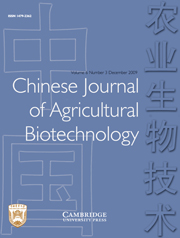No CrossRef data available.
Article contents
An association between tyrosinase gene single nucleotide polymorphisms and melanin distribution in chicken
Published online by Cambridge University Press: 12 February 2007
Abstract
Tyrosinase (TYR) is a key enzyme of melanin biosynthesis. Single-strand conformation polymorphism (SSCP) analysis was applied to detect the single nucleotide polymorphisms (SNPs) in the upstream regulating region from -641 to -2125 bp of the TYR gene. Three SNPs were found in this region. Correlations were obtained between genotypes of the SNP sites and pigment traits in chicken parental and F2 generations of the Chinese Agricultural University (CAU) resource population. The chi-square test indicated that these mutations were significantly related to shank and body skin colours.
Keywords
Information
- Type
- Research Article
- Information
- Copyright
- Copyright © China Agricultural University and Cambridge University Press 2005
References
Boissy, RE, Moellmann, GE and Halaban, R (1987) Tyrosinase and acid phosphatase activities in malanocytes from avian albinos. Journal of Investigative Dermatology 88: 292–300.CrossRefGoogle Scholar
Deng, XM (2001) Construction of Chicken Resource Population for Gene Mapping and Genetic Analysis of Melanin and Other Quality Traits. Beijing: China Agricultural University (in Chinese).Google Scholar
Giebel, LB, Strunk, KM and Spritz, RA (1991) Organization and nucleotide sequences of the human tyrosinase gene and a truncated tyrosinase-related segment. Genomics 9: 435–445.CrossRefGoogle Scholar
Jackson, IJ (1994) Molecular and developmental genetics of mouse coat color. Annual Review of Genetics 28: 189–217.CrossRefGoogle ScholarPubMed
Jiang, YL, Li, N, Xi, QY and Wu, CX (2000) Detection of point mutation of porcine estrogen receptor gene (ESR) by PCR2SSCP approach. Hereditas (Beijing) 22(4): 214–216.Google Scholar
Methot, D, Reudelhuber, TL and Silversides, DW (1995) Evaluation of tyrosinase minigene co-injection as a marker for genetic manipulations in transgenic mice. Nucleic Acids Research 23: 4551–4556.CrossRefGoogle ScholarPubMed

